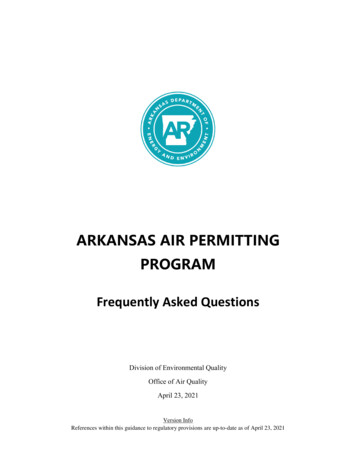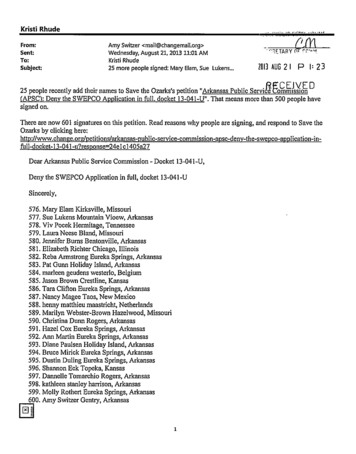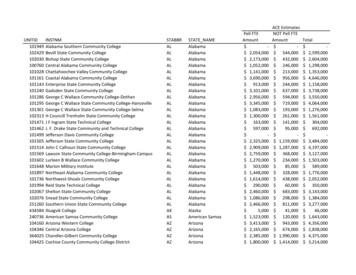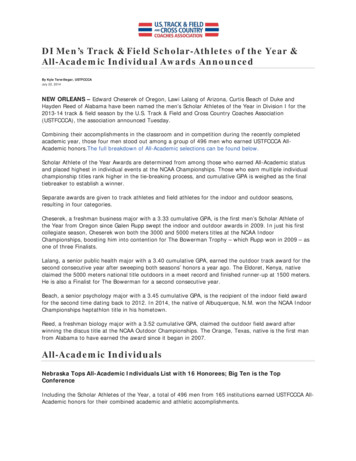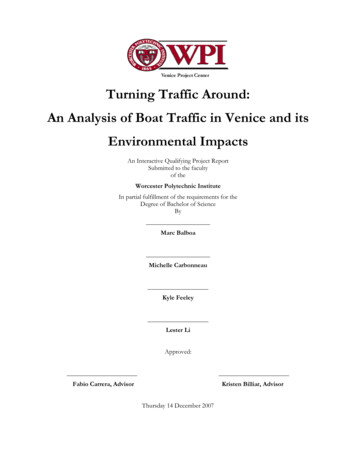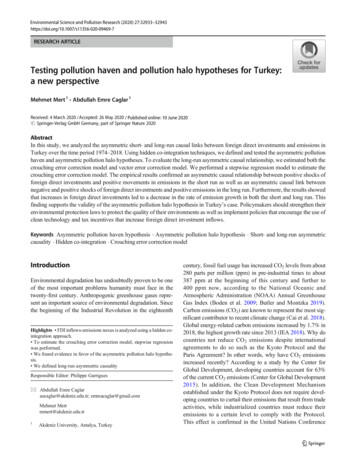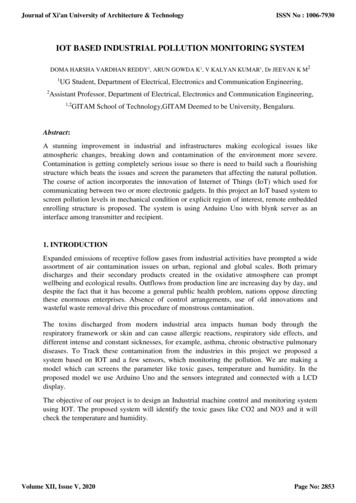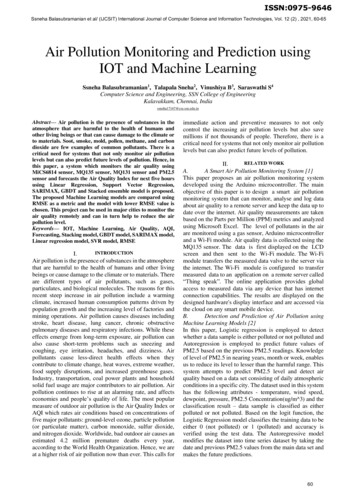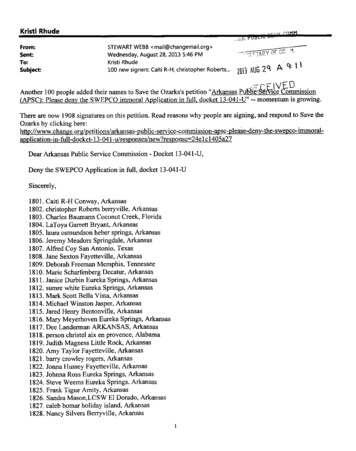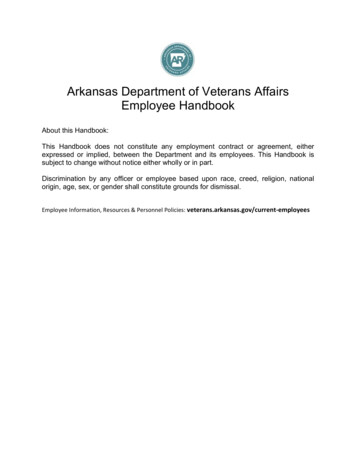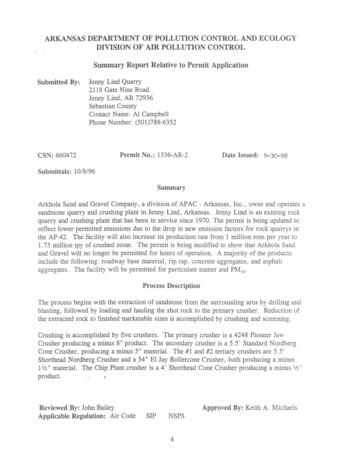
Transcription
ARKANSAS DEPARTMENT OF POLLUTION CONTROL AND ECOLOGYDIVISION OF AIR POLLUTION CONTROLSummarySubmittedBy:Relativeto PermitApplicationJenny Lind Quarry2118 Gate Nine RoadJenny Lind, AR 72936Sebastian CountyContact Name: Al CampbellPhone Number: (501)788-6352CSN: 660472Submittals:ReportPermit No.: 1336-AR-2Date Issued:9-30-9810/8/96SummaryArkhola Sand and Gravel Company, a division of APAC - Arkansas, Inc., owns and operates asandstone quarry and crushing plant in Jenny Lind, Arkansas. Jenny Lind is an existing rockquarry and crushing plant that has been in service since 1970. The permit is being updated toreflect lower permitted emissions due to the drop in new emission factors for rock quarrys inthe AP-42. The facility will also increase its production rate from 1 million tons per year to1.75 million tpy of crushed stone. The permit is being modified to show that Arkhola Sandand Gravel will no longer be permitted for hours of operation. A majority of the productsinclude the following: roadway base material, rip rap, concrete aggregates, and asphaltaggregates. The facility will be permitted for particulate matter and PMIO.Process DescriptionThe process begins with the extraction of sandstone from the surrounding area by drilling andblasting, followed by loading and hauling the shot rock to the primary crusher. Reduction ofthe extracted rock to finished marketable sizes is accomplished by crushing and screening.Crushing is accomplished by five crushers. The primary crusher is a 4248 Pioneer JawCrusher producing a minus 8" product. The secondary crusher is a 5.5' Standard NordbergCone Crusher, producing a minus 5" material. The #1 and #2 tertiary crushers are 5.5'Shorthead Nordberg Crusher and a 54" EI Jay Rollercone Crusher, both producing a minus11/2" material.The Chip Plant crusher is a 4' Shorthead Cone Crusher producing a minus 1/2"product.·Reviewed By: John BaileyApplicable Regulation: Air CodeApproved By: Keith A. MichaelsSIPNSPS4
Jenny Lind QuarryPermit # 1336-AR-2CSN: 660472Screening is accomplished by: A 5' x 10' Mesabi Screen which separates base material fromoversized material; two 6' x 16' two deck vibrating screens which separate oversize materialfrom concrete rock and base material and fine material from oversize material; two 6' x 16'three deck vibrating screens which separate different size fractions of concrete and asphaltaggregates from oversize material and fine material ; and a 6' x 16' three deck vibrating screenwhich separates chips from oversize and fine material.End dump haul trucks are used to transport the finished product to open air stockpiles, wherethe products are sold by loading the material into dump trucks by front end loaders.RegulationsArkhola is subject to regulation under the Arkansas Air Pollution Control Code and theregulations of the Arkansas Plan of Implementation for Air Pollution Control (SIP). Allequipment that is installed, reconstructed, or modified after August 31, 1983 (SN-08, 09, and13) is subject to the requirements of New Source Peiformance Standards of the 40 CFR, asfound in Subpart 000 - Standards of Performance for Nonmetallic Mineral Processing Plants.See Attachment A.5
Jenny Lind QuarryPermit # 1336-AR-2CSN: 660472Specific Conditions1.Emissions shall not exceed the limits specified in Table I of this Permit and asspecified in the Specific Conditions.2.Visible emissions shall not exceed the limits specified in Table I of this permit asmeasured by EPA Reference Method 9.3.All emission control equipment associated with this facility shall be maintained andoperated in serviceable condition as prescribed by the manufacturer during operation ofthis facility.4.All equipment that is installed, reconstructed, or modified after August 31, 1983 (SN08, 09, and 13) is subject to the requirements of New Source Peiformance Standards ofthe 40 CFR, as found in Subpart 000 - Standards of Performance for NonmetallicMineral Processing Plants. See attachment A.5.All crushers and screens at the facility shall be equipped with water sprays to controldust emissions. Operating of any screen or crusher when the water spray is notoperating shall be a violation of this permit. This condition does not apply when theraw material is sufficiently wet to cause no visible emissions.6.The permittee shall water all processes, storage piles and haul roads as needed toensure that the opacity limits in Table I of the permit are not exceeded and that novisible emissions extend beyond the property line of the facility.7.The maximum throughput permitted for this facility is 1.75 million tpy of crushedstone based on a 12 month rolling period. Production records are maintained by theactual quantity of product weighed and hauled away from the plant. Monthly recordsshall be maintained on site and made available for inspection by Air Division personnelupon request. These records shall be updated by the last day of the following month,kept on site and provided to Department personnel upon request.8.In accordance with General Condition #5 the permittee shall test quarry operationsources SN-08, 09, and 13 to determine compliance with opacity limits specified inTable I of this permit. EP A Reference Method 9 shall be used with the additionsoutlined in the 40 CFR Subpart 000, Section 60.675(c). The permittee shall submitwritten reports of the results of these performance tests every three years to theaddress listed below to demonstrate compliance.Arkansas Department of Pollution Control and EcologyAir DivisionATTN: Compliance Inspector SupervisorP.O. Box 8913Little Rock, Arkansas 72219-89136
Jenny Lind QuarryPermit # 1336-AR-2CSN: 6604729.The permittee shall not make any changes in operation and/or production without firstmodifying this permit.10.Upon issuance, this permit shall void and supersede all previous air permits issued tothis facility. Air Permit 1336-AR-l is hereby revoked.7
Jenny.j QuarryPermit # 1336-AR-2CSN: 660472TABLE erSpray#1#2TertiaryCrusherWaterWaterSpraySprayPM 10DescriptionRegulationWaterSpraylb/hrALLOW ABLE EMISSION RATES8
Jenny Lind QuarryPermit # 1336-AR-2CSN: J rayTruckWaterSprayCollectionPM* AP-42 Sections 13.2.2 and 13.2.4 indicate that PM emission factors may be estimated bymultiplyingPMIOby 2.19
Appendix A
Subpart OOO-Standards of Performancefor NonmetallicMineral ProcessingPlantsSOURCE: 51 FR 31337, Aug. I, 1985, unless otherwisenoted.§ 60.670 Applicability and designationof affected facility.(a) Except as provided in paragraphs (b), (c)and (d) of this section, the provisions of this subpart are applicable to the following affected facilities in fIxed or portable nonmetallic mineral processing plants: each crusher, grinding mill, screening operation, bucket elevator, belt conveyor, bagging operation, storage bin, enclosed truck or railcar loading station.(b) An affected facility that is subject to theprovisions of subpart F or I or that follows in theplant process any facility subject to the provisionsof subparts F or I of this part is not subject to theprovisions of this subpart.(c) Facilities at the following plants are not subject to the provisions of this subpart:(I) Fixed sand and gravel plants and crushedstone plants with capacities, as defined in§ 60.671, of 23 megagrams per hour (25 tons perhour) or less;(2) Portable sand and gravel plants and crushedstone plants with capacities, as defined in§ 60.671, of 136 megagrarns per hour (150 tonsper hour) or less; and(3) Common clay plants and pumice plants withcapacities, as defined in § 60.671, of 9 megagramsper hour (10 tons per hour) or less.(d)(I) When an existing facility is replaced bya piece of equipment of equal or smaller size, asdefined in § 60.671, having the same function asthe existing facility, the new facility is exemptfrom the provisions of §§ 60.672, 60.674, and60.675 except as provided for in paragraph (d)(3)of this section.(2) An owner or operator seeking to complywith this paragraph shall comply with the reporting requirements of § 60.676 (a) and (b).(3) An owner or operator replacing all existingfacilities in a production line with new facilitiesdoes not qualify for the exemption described inparagraph (d)(I) of this section and must complywith the provisions of §§ 60.672, 60.674 and60.675.(e) An affected facility under paragraph (a) ofthis section that' commences construction, reconstruction, or modification after August 31, 1983 issubject to the requirements of this part.§ 60.671 Definitions.AIl terms used in this subpart, but not specifically defined in this section, shall have the mean-ing given them in the Act and in subpart A of thispart.Bagging operation means the mechanical process by which bags are filled with nonmetallic minerals.Belt conveyor means a conveying device thattransports material from one location to another bymeans of an endless belt that is carried on a seriesof idlers and routed around a pulley at each end.Bucket elevator means a conveying device ofnonmetallic minerals consisting of a head and footassembly which supports and drives an endlesssingle or double strand chain or belt to whichbuckets are attached.Building means any frame structure with a roof.Capacity means the cumulative rated capacity ofall initial crushers that are part of the plant.Capture system means the equipment (includingenclosures, hoods, ducts, fans, dampers, etc.) usedto capture and transport particulate matter generated by one or more process operations to a control devi,ce.Control device means the air pollution controlequipment used to reduce particulate matter emissions released to the atmosphere from one or moreprocess operations at a nonmetallic mineral processing plant.Conveying system means a device for transporting materials from one piece of equipment or location to another location within a plant. Conveyingsystems include but are not limited to the following: Feeders, belt conveyors, bucket elevators andpneumatic systems.Crusher means a machine used to crush anynonmetallic minerals, and includes, but is not limited to, the following types: jaw, gyratory, cone,roll, rod mill, hammermill, and impactor.Enclosed truck or railcar loading station meansthat portion of a nonmetallic mineral processingplant where nonmetallic minerals are loaded by anenclosed conveying system into enclosed trucks orrailcars .Fixed plant means any nonmetallic mineralprocessing plant at which the processing equipment specified in § 6O.670(a) is attached by acable, chain, turnbuckle, bolt or other means (except electrical connections) to any anchor, slab, orstructure including bedrock.Fugitive emission means particulate matter thatis not collected by a capture system and is released to the atmosphere at the point of generation.Grinding mill means a machine used for the wetor dry fine crushing of any nonmetalJic mineral.Grinding mills include, but are not limited to, thefollowing types: hammer, roller, rod, pebble andball, and fluid energy. The grinding mill includesthe air conveying system, air separator, or air classifier, where such systems are used.
§ 60.672Initial crusher means any crusher into whichnonmetallic minerals can be fed without priorcrushing in the plant.Nonmetallic mineral means any of the followingminerals or any mixture of which the majority isany of the following minerals:(a) Crushed and Broken Stone, including Limestone, Dolomite, Granite, Traprock, Sandstone,Quartz, Quartzite, Marl, Marble, Slate, Shale, OilShale, and Shell.(b) Sand and Gravel.(c) Clay including Kaolin, Fireclay, Bentonite,Fuller's Earth, Ball Clay, and Common Clay.(d) Rock Salt.(e) Gypsum.(f) Sodium Compounds, including Sodium Carbonate, Sodium Chloride, and Sodium Sulfate.(g) Pumice.(h) Gilsonite.(i) Talc and Pyrophyllite.(j) Boron, including Borax, Kernite, andColemanite.(k) Barite.(I) Fluorospar.(m) Feldspar.(n) Diatomite.(0) Perlite.(p) Vermiculite.(q) Mica.(r) Kyanite, including Andalusite, Sillimanite,Topaz, and Dumortierite.Nonmetallic mineral processing plant meansany combination of equipment that is used tocrush or grind any nonmetallic mineral whereverlocated, including lime plants, power plants, steelmills, asphalt concrete plants, portland cementplants, or any other facility processing nonmetallicminerals except as provided in § 60.670 (b) and(screens) in series, and retaining oversize materialon the mesh surfaces (screens).Size means the rated capacity in tons per hourof a crusher, grinding mill, bucket elevator, bagging operation, or enclosed truck or railcar loadingstation; the total surface area of the top screen ofa screening operation; the width of a conveyorbelt; and the rated capacity in tons of a storagebin.Stack emission means the particulate matter thatis released to the atmosphere from a capture system.Storage bin means a facility for storage (including surge bins) or nonmetallic minerals prior tofurther processing or loading.Transfer point means a point in a conveying operation where the nonmetallic mineral is transferred to or from a belt conveyor except where thenonmetallic mineral is being transferred to a stockpile.Truck dumping means the unloading of nonmetallic minerals from movable vehicles designedto transport nonmetallic minerals from one location to another. Movable vehicles include but arenot limited to: trucks, front end loaders, skiphoists, and railcars.Vent means an opening through which there ismechanically induced air flow for the purpose ofexhausting from a building air carrying particulatematter emissions from one or more affected facilities.§ 60.672 Standard for particulate mat-ter.(a) On and after the date on which the performance test required to be conducted by § 60.8 iscompleted, no owner or operator subject to theprovisions of this subpart shall cause to be discharged into the atmosphere from any transferpoint on belt conveyors or from any other affectedfacility any stack emissions which:(1) Contain particulaie matter in excess of 0.05gldscm; or(2) Exhibit greater than 7 percent opacity, unless the stack emissions are discharged from an affected facility using a wet scrubbing control device. Facilities using a wet scrubber must complywith the reporting provisions of § 60.676 (c), (d),and (e).(b) On and after the sixtieth day after achievingthe maximum production rate at which the affected facility will be operated, but not later than180 days after initial startup, no owner or operatorsubject to the provisions of this subpart shall causeto be discharged into the atmosphere from anytransfer point on belt conveyors or from any otheraffected facility any fugitive emissions which exhibit greater than 10 percent opacity, except as(c).Portable plant means any nonmetallic mineralprocessing plant that is mounted on any chassis orskids and may be moved by the application of alifting or pulling force. In addition, there shall beno cable, chain, turnbuckle, bolt or other means(except electrical connections) by which any pieceof equipment is attached or clamped to any anchor, slab, or structure, including bedrock thatmust be removed prior to the application of a lifting or pulling force for the purpose of transportingthe unit.Production line means all affected facilities(crushers, ,grinding' mills, screening operations,bucket elevators, belt conveyors, bagging operations, storage bins, and enclosed truck and railcarloading stations) which are directly connected orare connected together by a conveying system.Screening operation means a device for separating material according to size by passing undersizematerial through one or more mesh surfaces2
§ 60.675scrubber. The monitoring device must be certifiedby the manufacturer to be accurate within 250pascals I inch water gauge pressure and must becalibrated on an annual basis in accordance withmanufacturer's instrUctions.(b) A device for the continuous measurement ofthe scrubbing liquid flow rate to the wet scrubber.The monitoring device must be certified by themanufacturer to be accurate within 5 percent ofdesign scrubbing liquid flow rate and must be calibrated on an annual basis in accordance with manufacturer's instrUctions.provided in paragraphs (c), (d) and (e) of this section.(c) On and after the sixtieth day after achievingthe maximum production rate at which the affected facility will be operated, but not later than180 days after initial startup, no owner or operatorshall cause to be discharged into the atmospherefrom any crusher, at which a capture system is notused, fugitive emissions which exhibit greater than15 percent opacity.(d) Truck dumping of nonmetallic minerals intoany screening operation, feed hopper, or crusher isexempt from the requirements of this section.(e) If any transfer point on a conveyor belt orany other affected facility is enclosed in a building, then each enclosed affected facility must comply with the emission limits in paragraphs (a), (b)and (c) of this section, or the building enclosingthe affected facility or facilities must comply withthe following emission limits:(I) No owner or operator shall cause to be discharged into the atmosphere from any building enclosing any transfer point on a conveyor belt orany other affected facility any visible fugitiveemissions except emissions from a vent as definedin § 60.67 J.(2) No owner or operator shall cause to be discharged into the atmosphere from any vent of anybuilding enclosing any transfer point on a conveyor belt or any other affected facility emissionswhich exceed the stack emissions limits in paragraph (a) of this section.§60.675 Test methods and procedures.(a) In conducting the perfonnance tests requiredin § 60.8, the owner or operator shall use as reference methods and procedures the test methods inappendix A 'of this part or other methods and procedures as specified in this section, except as provided in § 60.8(b). Acceptable alternative methodsand procedures are given in paragraph (e) of thissection.(b) The owner or operator shall determine compliance with the particulate matter standards in§ 60.272(a) as follows:(I) Method 5 or Method 17 shall be used to determine the particulate matter concentration. Thesample volume shall be at least 1.70 dscm (60dscf). For Method 5, if the gas stream being sampled is at ambient temperature, the sampling probeand filter may be operated without heaters. If thegas stream is above ambient temperature, the sampling probe and filter may be operated at a temperature high enough, but no higher than 121 C(250 oF), to prevent water condensation on the filter.(2) Method 9 and the procedures in § 60.11shall be used to determine opacity.(c) In determining compliance with the particulate matter standards in § 60.672 (b) and (c). theowner or operator shall use Method 9 and the procedures in § 60.11. with the following additions:(I) The minimum distance between the observerand the emission source shall be 4.57 meters (15feet).(2) The observer shall, when possible, select aposition that minimizes interference from other fugitive emission sources (e.g., road dust). The required observer position relative to the sun (Method 9, Section 2.1) must be followed.(3) For affected facilities using wet dust suppression for particulate matter control, a visiblemist is sometimes generated by the spray. Thewater mist must not be confused with particulatematter emissions and is not to be considered avisible emission. When a water mist of this natureis present, the observation of emissions is to bemade at a point in the plume where the mist is nolonger visible.§ 60.673 Reconstruction.(a) The cost of replacement of ore-contact surfaces on processing equipment shall not be considered in calculating either the "fixed capital cost ofthe new components" or the "fixed capital costthat would be required to construct a comparablenew facility" under § 60.15. Ore-contact surfacesare crushing surfaces; screen meshes, bars, andplates; conveyor belts; and elevator buckets.(b) Under § 60.15. the "fixed capital cost of thenew components" includes the fixed capital costof all depreciable components (except componentsspecified in paragraph (a) of this section) whichare or will be replaced pursuant to all continuousprograms of component replacement commencedwithin any 2-year period following August 31.1983.§ 60.674 Monitoring of operations.The owner or operator of any affected facilitysubject 10 the provisions of this subpart whichuses a wet scrubber to control emissions shall install, calibrate, maintain and operate the followingmonitoring devices:(a) A device for the continuous measurement ofthe pressure loss of the gas stream through the3
§ 60.676(d) In determining compliance with § 60.672(e),the owner or operator shall use Method 22 to determine fugitive emissions. The performance testshall be conducted while all affected facilities inside the building are operating. The performancetest for each building shall be at least 75 minutesin duration, with each side of the building and theroof being observed for at least 15 minutes.(e) The owner or operator may use the following as alternatives to the reference methods andprocedures specified in this section:(I) For the method and procedure of paragraph(c) of this section, if emissions from two or morefacilities continuously interfere so that the opacityof fugitive emissions from an individual affectedfacility cannot be read, either of the following procedures may be used:(i) Use for the combined emission stream thehighest fugitive opacity standard applicable to anyof the individual affected facilities contributing tothe emissions stream.(ii) Separate the emissions so that the opacity ofemissions from each affected facility can be read.(f) To comply with § 60.676(d), the owner oroperator shall record the measurements as requiredin § 60.676(c) using the monitoring devices in§ 60.674 (a) and (b) during each particulate matterrun and shall determine the averages.(i) The rated capacity in tons of the existingstorage bin being replaced and(ii) The rated capacity in tons of replacementstorage bins.(b) Each owner or operator seeking to complywith § 60.670(d) shall submit the following data tothe Director of the Emission Standards and Engineering Division, (MD-13), U.S. EnvironmentalProtection Agency, Research Triangle Park, NorthCarolina 27711.(1) The information described in § 60.676(a).(2) A description of the control device used toreduce particulate matter emissions from the existing facility and a list of all other pieces of equipment controlled by the same control device; and(3) The estimated age of the existing facility.(c) During the initial performance test of a wetscrubber, and daily thereafter, the owner or operator shall record the measurementsof both the(a) Each owner or operator seeking to complywith § 60.670(d) shall submit to the Administratorthe following information about the existing facility being replaced and the replacement piece ofequipment.(I) For a crusher, grinding mill, bucket elevator,bagging operation, or enclosed truck or railcarloading station:(i) The rated capacity in· tons per hour of theexisting facility being replaced and(ii) The rated capacity in tons per hour of thereplacement equipment.(2) For a screening operation:(i) The total surface area of the top screen ofthe existing screening operation being replacedandchange in pressure of the gas stream across thescrubber apd the scrubbing liquid flow rate.(d) After the initial performance test of a wetscrubber, the owner or operator shall submit semiannual reports to the Administrator of occurrenceswhen the measurements of the scrubber pressureloss (or gain) and liquid flow rate differ by morethan 30 percent from the averaged determinedduring the most recent performance test.(e) The reports required under paragraph (d)shall be postmarked within 30 days following endof the second and fourth calendar quarters.(f) The owner or operator of any affected facility shall submit written reports of the results of allperformance tests conducted to demonstrate compliance with the standards set forth in § 60.672, including reports of opacity observations made usingMethod9 to demonstratecompliancewith§ 60.672 (b) and (c) and reports of observationsusing Method 22 to demonstrate compliance with§ 60.672(e).(g) The requirements of this paragraph remainin force until and unless the Agency, in delegatingenforcement authority to a State under section111(c) of the Act, approves reporting requirementsor an alternative means of compliance surveillanceadopted by such States. In that event, affectedsources within the State will be relieved of the ob-(ii) The total surface area of the top screen ofthe replacement screening operation.(3) For a conveyor belt:(i) The width of the existing belt being replacedand ligation to comply with paragraphs (a), (c), (d),(e), and (f) of this section, provided that they comply with requirements established by the State.Compliance with paragraph (b) of this section willstill be required.[54 FR 6680, Feb. 14, 1989]§60.676 Reporting and recordkeeping.(ii) The width of the replacement(4) For a storage bin:conveyor.belt.[51 FR 31337, Aug. I, 1985, as amended at 54 FR 6680,Feb. 14, 1989]4
CERTIFICATE OF SERVICEI, Keith A. Michaels, hereby certify that a copy of this permit has been mailedby first class mail to Arkhola Division, APAC Arkansas, Inc., Jenny Lind Quarry,P. O. Box 1627, Fort Smith, Arkansas 72902, on thisSeptember3.D.tb, 1998.YaM --Keith A. Michaels, Chief, Air Divisionday of
which separates chips from oversize and fine material. End dump haul trucks are used to transport the finished product to open air stockpiles, where the products are sold by loading the material into dump trucks by front end loaders. Regulations Arkhola is subject to regulation under the Arkansas Air Pollution Control Code and the
